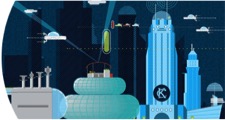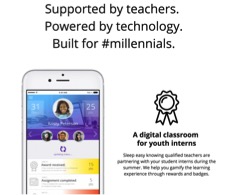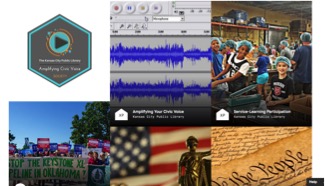The Infrastructure of Learning in a Net-Centric City

Who will you meet?
Cities are innovating, companies are pivoting, and start-ups are growing. Like you, every urban practitioner has a remarkable story of insight and challenge from the past year.
Meet these peers and discuss the future of cities in the new Meeting of the Minds Executive Cohort Program. Replace boring virtual summits with facilitated, online, small-group discussions where you can make real connections with extraordinary, like-minded people.
 Kansas City is a net-centric, digital city. To be fair, this is a self-appointed label, but nonetheless, Kansas City makes a good case for it. I believe that net-centricity is a status, not a state, and we are constantly striving toward that goal. Cities are usually place-centric: you go to a particular place in order to do a particular thing. But now digital is not just a method, it’s a strategy, and when it comes to learning and education, the infrastructure of how information moves and is accessed creates a new opportunity for cities to reimagine how this information serves our community and its citizens in the connected age.
Kansas City is a net-centric, digital city. To be fair, this is a self-appointed label, but nonetheless, Kansas City makes a good case for it. I believe that net-centricity is a status, not a state, and we are constantly striving toward that goal. Cities are usually place-centric: you go to a particular place in order to do a particular thing. But now digital is not just a method, it’s a strategy, and when it comes to learning and education, the infrastructure of how information moves and is accessed creates a new opportunity for cities to reimagine how this information serves our community and its citizens in the connected age.
In 2012, Google Fiber selected Kansas City as the location for its first fiberhood: the first neighborhood ever to receive gigabit internet. In response, Kansas City launched an entire strategy around how we communicate, engage, recreate, entertain, work, educate, interact, and learn in our community. The city created the KC Startup Village, a row of houses that were among the first to receive Google’s lightning-fast Internet. Computation-heavy and data-hungry startups moved in to get the goods; at the time, the fiber optic service was only available to residential customers. The innovation catapulted our city’s economic development agenda and allowed KC to swiftly rise in the ranks of scrappy tech hubs — where accelerators, incubators, investors, and coworking spaces made a rapid leap into the fray.
It was easy to see the new focus as Kansas City Mayor Sly James began to invest in innovation. He hired the city’s first Chief Innovation Officer in 2013 — now a regular post in municipalities of all shapes and sizes — and he created a bi-state team of private citizens to advise on city-wide innovation strategies.
Kansas City is one of those Goldilocks cities: not too big and not too small. It’s a great place to test ideas, buy a house, raise a family, or launch a startup. We are home to the largest smart city project in North America. Can you imagine the economic advantage that comes with that kind of tech profile? It comes to town by way of Google, Cisco, and other techies and is amplified by our local heroes like Sprint, H&R Block, AMC Theaters, Cerner, and Hallmark. We call ourselves a city among these national and global initiatives:
- MetroLab Network
- US Ignite Gigabit City
- IEEE Core Smart City
- Mozilla Gigabit Fund
- Bloomberg What Works Cities
- Next Century Cities
- Digital Promise Education Innovation Cluster
- My Brother’s Keeper Alliance
- STEM Learning Ecosystem
- Village Capital “VilCap” Community
- YouMedia Network
- LRNG
 However, we are not without our dark side and our challenges. How does a Midwestern city that’s not too big and not too small possibly address the human capital disparity that comes sharply into focus when we are faced with the fact that:
However, we are not without our dark side and our challenges. How does a Midwestern city that’s not too big and not too small possibly address the human capital disparity that comes sharply into focus when we are faced with the fact that:
- Most of our people don’t see the relevance of gigabit or high-speed Internet, or are not connected at all;
- Don’t know what a “smart city” is;
- Have never heard of the Internet of Things; and
- They’re simply not connected meaningfully to the very thing that is putting KC on the map?
All of this — the good, the bad, and the net-centric — eventually sets the stage for the development of the critical community ecosystems needed to support it. Among them is learning — arguably the most important instrument for an inclusive and socially just city.
 Learning is the mechanism we use to develop human capital. We call it infrastructure, akin to roads, power, transportation, and our friend the Internet. When you frame education as learning and highlight the dotted line to human capital, you suddenly have permission to think about the economics of equity and social mobility and to empower rather than intervene — to innovate rather than solve. Human capital connects city government, economic development agencies, industry, higher education and philanthropy to the same shared vision: skilled people doing the things that make the city the best version of itself, while giving the people the freedom and capacity they deserve to be the best they can be.
Learning is the mechanism we use to develop human capital. We call it infrastructure, akin to roads, power, transportation, and our friend the Internet. When you frame education as learning and highlight the dotted line to human capital, you suddenly have permission to think about the economics of equity and social mobility and to empower rather than intervene — to innovate rather than solve. Human capital connects city government, economic development agencies, industry, higher education and philanthropy to the same shared vision: skilled people doing the things that make the city the best version of itself, while giving the people the freedom and capacity they deserve to be the best they can be.
We’ve been testing this for a while. It’s amazing what a bit of risk tolerance will allow. It brings about innovative pilots that disrupt our learning systems, methods, and even the way humans support and work in these systems.
 We are disrupting youth employment with totally new technology, new platforms, and new programs to develop precious talent from the inner city, and we’re scaling it. At the center of our work is the LRNG digital platform — connecting learning experiences across the city to make learning more discoverable and accessible to all. LRNG launched in KC this summer after we were one of 12 new pilot cities selected through an application process. This wouldn’t have been possible without our hard work and that of our partners, including Mayor Sly James and the City of Kansas City, Missouri, KC Public Library, and the KC STEM Alliance. LRNG provides KC youth the ability to earn digital badges — credentials that validate their learning in all its many shapes and forms.
We are disrupting youth employment with totally new technology, new platforms, and new programs to develop precious talent from the inner city, and we’re scaling it. At the center of our work is the LRNG digital platform — connecting learning experiences across the city to make learning more discoverable and accessible to all. LRNG launched in KC this summer after we were one of 12 new pilot cities selected through an application process. This wouldn’t have been possible without our hard work and that of our partners, including Mayor Sly James and the City of Kansas City, Missouri, KC Public Library, and the KC STEM Alliance. LRNG provides KC youth the ability to earn digital badges — credentials that validate their learning in all its many shapes and forms.
We’ve baked LRNG into our summer youth internship and employment program; it’s central to federal programs piloted in KC that aim to establish more college and career pathways, connect the disconnected, and train the under-employed. It has landed squarely in the strategic vision of many of our core programs. We imagine the net-centric state of our city powered in part by the learning achieved, earned, and documented through LRNG, as well as the educators, trainers, and innovators who are the spokes in that hub.
Learning is infrastructure in a net-centric, digital city. We’re proof of that and proud of it.
Discussion
Leave your comment below, or reply to others.
Please note that this comment section is for thoughtful, on-topic discussions. Admin approval is required for all comments. Your comment may be edited if it contains grammatical errors. Low effort, self-promotional, or impolite comments will be deleted.
Read more from MeetingoftheMinds.org
Spotlighting innovations in urban sustainability and connected technology
Middle-Mile Networks: The Middleman of Internet Connectivity
The development of public, open-access middle mile infrastructure can expand internet networks closer to unserved and underserved communities while offering equal opportunity for ISPs to link cost effectively to last mile infrastructure. This strategy would connect more Americans to high-speed internet while also driving down prices by increasing competition among local ISPs.
In addition to potentially helping narrow the digital divide, middle mile infrastructure would also provide backup options for networks if one connection pathway fails, and it would help support regional economic development by connecting businesses.
Wildfire Risk Reduction: Connecting the Dots
One of the most visceral manifestations of the combined problems of urbanization and climate change are the enormous wildfires that engulf areas of the American West. Fire behavior itself is now changing. Over 120 years of well-intentioned fire suppression have created huge reserves of fuel which, when combined with warmer temperatures and drought-dried landscapes, create unstoppable fires that spread with extreme speed, jump fire-breaks, level entire towns, take lives and destroy hundreds of thousands of acres, even in landscapes that are conditioned to employ fire as part of their reproductive cycle.
ARISE-US recently held a very successful symposium, “Wildfire Risk Reduction – Connecting the Dots” for wildfire stakeholders – insurers, US Forest Service, engineers, fire awareness NGOs and others – to discuss the issues and their possible solutions. This article sets out some of the major points to emerge.
Innovating Our Way Out of Crisis
Whether deep freezes in Texas, wildfires in California, hurricanes along the Gulf Coast, or any other calamity, our innovations today will build the reliable, resilient, equitable, and prosperous grid tomorrow. Innovation, in short, combines the dream of what’s possible with the pragmatism of what’s practical. That’s the big-idea, hard-reality approach that helped transform Texas into the world’s energy powerhouse — from oil and gas to zero-emissions wind, sun, and, soon, geothermal.
It’s time to make the production and consumption of energy faster, smarter, cleaner, more resilient, and more efficient. Business leaders, political leaders, the energy sector, and savvy citizens have the power to put investment and practices in place that support a robust energy innovation ecosystem. So, saddle up.






0 Comments